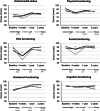Evaluating the longitudinal effect of colorectal surgery on health-related quality of life in patients with colorectal cancer
- PMID: 34569626
- PMCID: PMC9292688
- DOI: 10.1002/jso.26685
Evaluating the longitudinal effect of colorectal surgery on health-related quality of life in patients with colorectal cancer
Abstract
Background and objectives: Surgery for colorectal cancer (CRC) negatively affects health-related quality of life (HRQoL). Addressing shortcomings in literature, the purpose of this study was to evaluate the impact of surgery for CRC on the course of HRQoL from baseline up to 2 years after diagnosis.
Methods: In this prospective, population-based study patients with newly diagnosed CRC were included between 2016 and 2019. HRQoL was assessed by the EORTC QLQ-C30 questionnaire over time both between and within subgroups of patients that underwent right-sided colonic, left-sided colonic, and rectal resection using linear mixed model analyses.
Results: The study included 415 patients of whom 148 patients underwent right-sided colonic (36%), 147 left-sided colonic (35%), and 120 rectal resection (29%). Overall, HRQoL scores restored to baseline level 1 year after diagnosis. Impact of surgery seems to be more prominent in patients who underwent rectal resection, as they experienced more pain and had worse role and social functioning scores 4 weeks after surgery. Finally, among patients who underwent left-sided and rectal resection, physical functioning did not return to baseline level during follow-up.
Conclusion: This study shows several differences (between-group and within-group) in HRQoL according to surgery type and offers perspective which patients may need additional support in the care pathway.
Keywords: PROFILES; colorectal cancer; colorectal resection; health-related quality of life; recovery; surgery.
© 2021 The Authors. Journal of Surgical Oncology published by Wiley Periodicals LLC.
Conflict of interest statement
The authors declare that there are no conflict of interests.
Figures



Comment in
-
Evaluating the longitudinal effect of colorectal surgery on health-related quality of life in patients with colorectal cancer.J Surg Oncol. 2022 Jun;125(8):1332. doi: 10.1002/jso.26837. Epub 2022 Mar 30. J Surg Oncol. 2022. PMID: 35353371 No abstract available.
References
-
- Bray F, Ferlay J, Soerjomataram I, Siegel RL, Torre LA, Jemal A. Global cancer statistics 2018: GLOBOCAN estimates of incidence and mortality worldwide for 36 cancers in 185 countries. CA Cancer J Clin. 2018;68(6):394‐424. - PubMed
-
- Dekker E, Tanis PJ, Vleugels JLA, Kasi PM, Wallace MB. Colorectal cancer. Lancet. 2019;394(10207):1467‐1480. - PubMed
-
- van de Poll‐Franse LV, Horevoorts N, van Eenbergen M, et al. The patient reported outcomes following initial treatment and long term evaluation of survivorship registry: scope, rationale and design of an infrastructure for the study of physical and psychosocial outcomes in cancer survivorship cohorts. Eur J Cancer. 2011;47(14):2188‐2194. - PubMed
-
- Hamaker ME, Prins MC, Schiphorst AH, van Tuyl SA, Pronk A, van den Bos F. Long‐term changes in physical capacity after colorectal cancer treatment. J Geriatr Oncol. 2015;6(2):153‐164. - PubMed
-
- Koëter T, Bonhof CS, Schoormans D, et al. Long‐term outcomes after surgery involving the pelvic floor in rectal cancer: physical activity, quality of life, and health status. J Gastrointest Surg. 2019;23(4):808‐817. - PubMed
Publication types
MeSH terms
LinkOut - more resources
Full Text Sources
Medical

